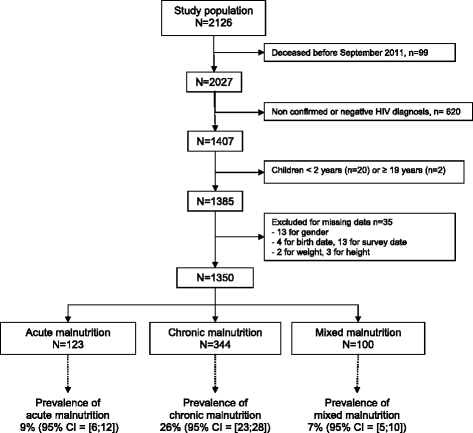Prevalence of malnutrition among HIV-infected children in Central and West-African HIV-care programmes supported by the Growing Up Programme in 2011: a cross-sectional study
- PMID: 26007232
- PMCID: PMC4494161
- DOI: 10.1186/s12879-015-0952-6
Prevalence of malnutrition among HIV-infected children in Central and West-African HIV-care programmes supported by the Growing Up Programme in 2011: a cross-sectional study
Abstract
Background: The burden of malnutrition among HIV-infected children is not well described in sub-Saharan Africa, even though it is an important problem to take into account to guarantee appropriate healthcare for these children. We assessed the prevalence of malnutrition and its associated factors among HIV-infected children in HIV care programmes in Central and West-Africa.
Methods: A cross-sectional study was conducted from September to December 2011 among the active files of HIV-infected children aged 2-19 years old, enrolled in HIV-care programmes supported by the Sidaction Growing Up Programme in Benin, Burundi, Cameroon, Côte d'Ivoire, Mali, Chad and Togo. Socio-demographics characteristics, anthropometric, clinical data, and nutritional support were collected. Anthropometric indicators, expressed in Z-scores, were used to define malnutrition: Height-for-age (HAZ), Weight-for-Height (WHZ) for children < 5 years and BMI-for-age (BAZ) for children ≥5 years. Three types of malnutrition were defined: acute malnutrition (WHZ/BAZ < -2 SD and HAZ ≥ -2 SD), chronic malnutrition (HAZ < -2 SD and WHZ/BAZ ≥ -2 SD) and mixed malnutrition (WHZ/BAZ < -2 SD and HAZ < -2 SD). A multinomial logistic regression model explored associated factors with each type of malnutrition.
Results: Overall, 1350 HIV-infected children were included; their median age was 10 years (interquartile range [IQR]: 7-13 years), 49 % were girls. 80 % were on antiretroviral treatment (ART), for a median time of 36 months. The prevalence of malnutrition was 42 % (95 % confidence interval [95% CI]: 40-44 %) with acute, chronic and mixed malnutrition at 9 % (95% CI: 6-12 %), 26 % (95% CI: 23-28 %), and 7 % (95% CI: 5-10 %), respectively. Among those malnourished, more than half of children didn't receive any nutritional support at the time of the survey. Acute malnutrition was associated with male gender, severe immunodeficiency, and the absence of ART; chronic malnutrition with male gender and age (<5 years); and mixed malnutrition with male gender, age (<5 years), severe immunodeficiency and recent ART initiation (<6 months). Orphanhood and Cotrimoxazole prophylaxis were not associated with any type of malnutrition.
Conclusions: The prevalence of malnutrition in HIV-infected children even on ART remains high in HIV care programmes. Anthropometric measurements and appropriate nutritional care of malnourished HIV-infected children remain insufficient and a priority to improve health care of HIV-infected children in Africa.
Figures
Similar articles
-
Effect of Age at Antiretroviral Therapy Initiation on Catch-up Growth Within the First 24 Months Among HIV-infected Children in the IeDEA West African Pediatric Cohort.Pediatr Infect Dis J. 2015 Jul;34(7):e159-68. doi: 10.1097/INF.0000000000000734. Pediatr Infect Dis J. 2015. PMID: 25955835 Free PMC article.
-
Growth in the first 5 years after antiretroviral therapy initiation among HIV-infected children in the IeDEA West African Pediatric Cohort.Trop Med Int Health. 2019 Jun;24(6):775-785. doi: 10.1111/tmi.13237. Epub 2019 Apr 15. Trop Med Int Health. 2019. PMID: 30945378 Free PMC article.
-
Malnutrition, Growth Response and Metabolic Changes Within the First 24 Months After ART Initiation in HIV-infected Children Treated Before the Age of 2 Years in West Africa.Pediatr Infect Dis J. 2018 Aug;37(8):781-787. doi: 10.1097/INF.0000000000001932. Pediatr Infect Dis J. 2018. PMID: 29406463
-
Challenges of malnutrition care among HIV-infected children on antiretroviral treatment in Africa.Med Mal Infect. 2015 May;45(5):149-56. doi: 10.1016/j.medmal.2015.03.002. Epub 2015 Apr 7. Med Mal Infect. 2015. PMID: 25861689 Review.
-
Prevalence of undernutrition and associated factors among adults taking antiretroviral therapy in sub-Saharan Africa: A systematic review and meta-analysis.PLoS One. 2023 Mar 24;18(3):e0283502. doi: 10.1371/journal.pone.0283502. eCollection 2023. PLoS One. 2023. PMID: 36961844 Free PMC article.
Cited by
-
Stunting and growth velocity of adolescents with perinatally acquired HIV: differential evolution for males and females. A multiregional analysis from the IeDEA global paediatric collaboration.J Int AIDS Soc. 2019 Nov;22(11):e25412. doi: 10.1002/jia2.25412. J Int AIDS Soc. 2019. PMID: 31702088 Free PMC article.
-
Time to develop severe acute malnutrition and its predictors among children living with HIV in the era of test and treat strategies at South Gondar hospitals, northwest, Ethiopia, 2021: a multicentre retrospective cohort study.BMC Pediatr. 2022 Jan 14;22(1):38. doi: 10.1186/s12887-021-03078-0. BMC Pediatr. 2022. PMID: 35031007 Free PMC article.
-
Prevalence and determinants of under-nutrition among children on ART in Ethiopia: A systematic review and meta-analysis.PLoS One. 2024 Jun 20;19(6):e0303292. doi: 10.1371/journal.pone.0303292. eCollection 2024. PLoS One. 2024. PMID: 38900809 Free PMC article.
-
Rate, risk factors and estimations of time to develop severe acute malnutrition after children receiving antiretroviral therapy at selected health facilities in northwest Ethiopia.J Nutr Sci. 2023 May 22;12:e60. doi: 10.1017/jns.2023.42. eCollection 2023. J Nutr Sci. 2023. PMID: 37252682 Free PMC article.
-
Magnitude of underweight, wasting and stunting among HIV positive children in East Africa: A systematic review and meta-analysis.PLoS One. 2020 Sep 17;15(9):e0238403. doi: 10.1371/journal.pone.0238403. eCollection 2020. PLoS One. 2020. PMID: 32941443 Free PMC article.
References
-
- UNAIDS . UNAIDS report on the global AIDS. Geneva, Switzerland: UNAIDS; 2013.
-
- United Nations Children’s Fund, World Health Organization, and World Bank. UNICEF-WHO-World Bank Joint Child Malnutrition Estimates. New York, USA: UNICEF; Geneva, Switzerland: WHO; and Washington DC, USA: World Bank; 2012
-
- WHO . World Health Statistics 2012. Geneva, Switzerland: World Health Organization; 2012.
Publication types
MeSH terms
Substances
LinkOut - more resources
Full Text Sources
Other Literature Sources
Medical


